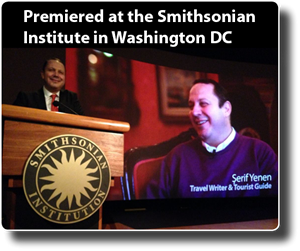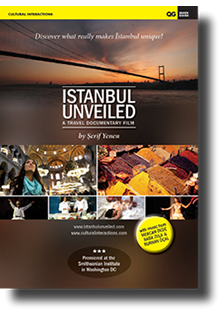Places
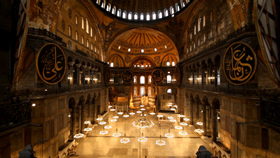 Hagia SophiaThroughout Byzantine and Ottoman history, for almost 1500 years, the Hagia Sophia has been the Imperial Church or Mosque. Emperors were crowned, victories were celebrated and Ottoman sultans prayed in this remarkable building.
Hagia SophiaThroughout Byzantine and Ottoman history, for almost 1500 years, the Hagia Sophia has been the Imperial Church or Mosque. Emperors were crowned, victories were celebrated and Ottoman sultans prayed in this remarkable building.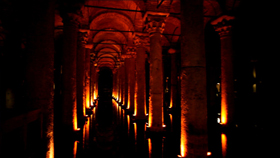 Basilica CisternThe largest and most ornate of the cisterns in İstanbul is Yerebatan Sarayı (Palace). Columns and capitals of earlier pagan temples were used in its construction, providing a very decorative appearance in an underground setting.
Basilica CisternThe largest and most ornate of the cisterns in İstanbul is Yerebatan Sarayı (Palace). Columns and capitals of earlier pagan temples were used in its construction, providing a very decorative appearance in an underground setting.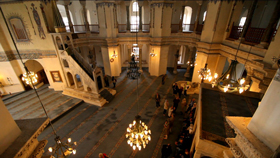 Küçük AyasofyaThe Church of Saints Sergius and Bacchus, an early example of the domed Byzantine style, was built by the Byzantine Emperor Justinian before 530 AD.
Küçük AyasofyaThe Church of Saints Sergius and Bacchus, an early example of the domed Byzantine style, was built by the Byzantine Emperor Justinian before 530 AD.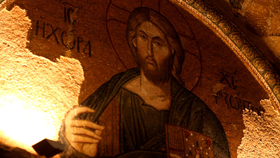 Chora MonasteryThe Church of the Holy Savior in Chora is among the top must-see museums in the world. It may well be accepted as the most important Byzantine monument in İstanbul after the Hagia Sophia.
Chora MonasteryThe Church of the Holy Savior in Chora is among the top must-see museums in the world. It may well be accepted as the most important Byzantine monument in İstanbul after the Hagia Sophia.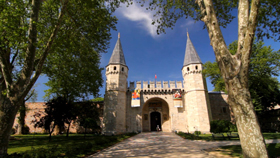 Topkapı PalaceTopkapı Palace, the imperial residence of the Sultan, his court and Harem, was also the center of the state administration. As each succeeding sultan ascended to the throne, he added parts to the palace, indicating to us the different tastes and styles of architecture over four centuries. In 1924 the palace was turned into a museum.
Topkapı PalaceTopkapı Palace, the imperial residence of the Sultan, his court and Harem, was also the center of the state administration. As each succeeding sultan ascended to the throne, he added parts to the palace, indicating to us the different tastes and styles of architecture over four centuries. In 1924 the palace was turned into a museum. 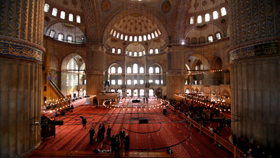 Blue MosqueBecause of its proximity to the Topkapı Palace, the Sultan Ahmed Mosque was regarded as the Supreme Imperial Mosque in İstanbul. Built by Sultan Ahmed I as a part of a large complex, it was originally called the Sultan Ahmed Mosque. However, visitors fascinated with the beautiful turquoise blue tiles always remember it as the Blue Mosque.
Blue MosqueBecause of its proximity to the Topkapı Palace, the Sultan Ahmed Mosque was regarded as the Supreme Imperial Mosque in İstanbul. Built by Sultan Ahmed I as a part of a large complex, it was originally called the Sultan Ahmed Mosque. However, visitors fascinated with the beautiful turquoise blue tiles always remember it as the Blue Mosque. 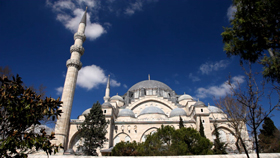 Süleymaniye MosqueSüleymaniye, more than a mosque, is an important historical symbol for the Turks. It unites Sinan with Süleyman the Magnificent, one representing the best of the arts and the other the most powerful in political strength.
Süleymaniye MosqueSüleymaniye, more than a mosque, is an important historical symbol for the Turks. It unites Sinan with Süleyman the Magnificent, one representing the best of the arts and the other the most powerful in political strength.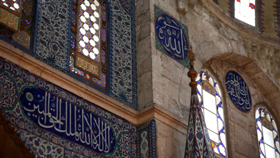 Sokollu MosqueThe 16th century Sokollu Mehmet Pasha Mosque was designed by Architect Sinan for Grand Vizier Sokollu Mehmet Paşa (husband of one of the granddaughters of Sultan Suleyman the Magnificent).
Sokollu MosqueThe 16th century Sokollu Mehmet Pasha Mosque was designed by Architect Sinan for Grand Vizier Sokollu Mehmet Paşa (husband of one of the granddaughters of Sultan Suleyman the Magnificent). The interior of the mosque is famous for its large quantities of İznik tiles.
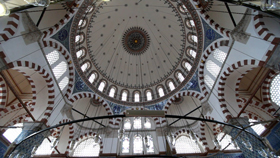 Rüstempaşa MosqueThe Rüstem Paşa Mosque was designed by Architect Sinan for Grand Vizier Rüstem Paşa in 1561. Rüstem Paşa was the husband of Mihrimah Sultan, the favorite daughter of Sultan Süleyman the Magnificent. With the use of large quantities of exquisite İznik tiles, which nearly cover the interior, this mosque is known to be one of the most ornate in Ottoman architecture.
Rüstempaşa MosqueThe Rüstem Paşa Mosque was designed by Architect Sinan for Grand Vizier Rüstem Paşa in 1561. Rüstem Paşa was the husband of Mihrimah Sultan, the favorite daughter of Sultan Süleyman the Magnificent. With the use of large quantities of exquisite İznik tiles, which nearly cover the interior, this mosque is known to be one of the most ornate in Ottoman architecture. 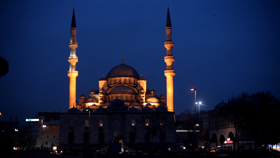 Yeni (New) MosqueThe construction of the New Mosque, ordered by Safiye Sultan (wife of Sultan Murad III), first began in 1597. Turhan Hatice Sultan, mother of Sultan Mehmed IV, employed the imperial architect Mustafa Ağa to finish it in 1663. The mosque has 66 domes and half-domes in a pyramidal arrangement.
Yeni (New) MosqueThe construction of the New Mosque, ordered by Safiye Sultan (wife of Sultan Murad III), first began in 1597. Turhan Hatice Sultan, mother of Sultan Mehmed IV, employed the imperial architect Mustafa Ağa to finish it in 1663. The mosque has 66 domes and half-domes in a pyramidal arrangement. 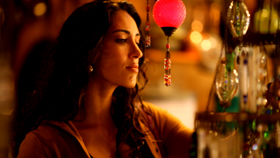 Grand BazaarWith more than four thousand shops, this bazaar covers an area of more than 30 hectares (75 acres), and it is one of the greatest and oldest in the world.
Grand BazaarWith more than four thousand shops, this bazaar covers an area of more than 30 hectares (75 acres), and it is one of the greatest and oldest in the world.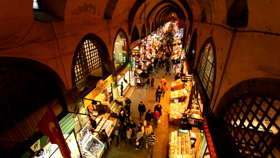 Egyptian BazaarStroll through the spice market and pick up some saffron or maybe some Turkish delight, lokum. Be sure to look around, taste and smell. You will enjoy this experience.
Egyptian BazaarStroll through the spice market and pick up some saffron or maybe some Turkish delight, lokum. Be sure to look around, taste and smell. You will enjoy this experience.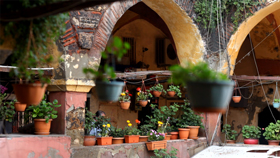 Hans (Caravansary) and BazaarsHans in İstanbul appeared at the time of Sultan Mehmed II and continued until the 20th century. In earlier times they were places for animals, people and storage of loads. But after the 15th century, these spaces were built separately. Typical hans would have courtyards in the center with multi-floored colonnades and rooms around the courtyard.
Hans (Caravansary) and BazaarsHans in İstanbul appeared at the time of Sultan Mehmed II and continued until the 20th century. In earlier times they were places for animals, people and storage of loads. But after the 15th century, these spaces were built separately. Typical hans would have courtyards in the center with multi-floored colonnades and rooms around the courtyard.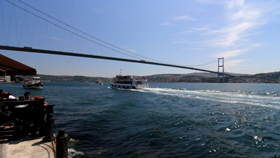 BosphorusThe Bosphorus is a narrow, navigable strait between Europe and Asia connecting the Black Sea to the Marmara Sea. It divides the city of İstanbul in two. The Bosphorus is famous for its yalı residences. These are among the most expensive residences in the world.
BosphorusThe Bosphorus is a narrow, navigable strait between Europe and Asia connecting the Black Sea to the Marmara Sea. It divides the city of İstanbul in two. The Bosphorus is famous for its yalı residences. These are among the most expensive residences in the world. 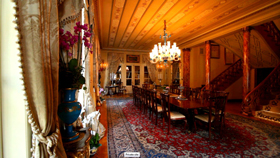 Zarif Mustafa Paşa Mansion (Yalı)The typical yalı residences on the Bosphorus are waterfront wooden houses or mansions. There are approximately 600 yalıs, most of which are from the 19th century. Zarif Mustafa Paşa Mansion is thought to have been from the late 17th century. It is one of the most important and the largest yalıs on the Bosphorus.
Zarif Mustafa Paşa Mansion (Yalı)The typical yalı residences on the Bosphorus are waterfront wooden houses or mansions. There are approximately 600 yalıs, most of which are from the 19th century. Zarif Mustafa Paşa Mansion is thought to have been from the late 17th century. It is one of the most important and the largest yalıs on the Bosphorus. 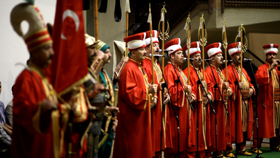 Military Band ConcertThe Turkish Military Band-Mehter is the oldest known military band in the world. Mehter accompanied the Ottoman Army marching into battles for many centuries. With its percussion, it instilled strength, confidence, and courage in the soldiers while intimidating the enemy. The Mehter Band performed in peace times also to help the morale of the people.
Military Band ConcertThe Turkish Military Band-Mehter is the oldest known military band in the world. Mehter accompanied the Ottoman Army marching into battles for many centuries. With its percussion, it instilled strength, confidence, and courage in the soldiers while intimidating the enemy. The Mehter Band performed in peace times also to help the morale of the people. 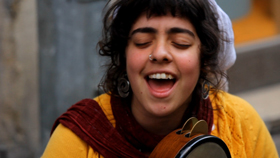 BeyoğluBeyoğlu is where the heart of the city beats, 24 hours a day. You can take a nostalgic tram ride, see antiques shops in Çukurcuma, visit churches, synagogues, cultural centers, bookstores, art galleries or museums, see the Neoclassical and Art Nouveau buildings, walk through the food and fish market, eat or drink something at the Asmalımescit or the Nevizade.
BeyoğluBeyoğlu is where the heart of the city beats, 24 hours a day. You can take a nostalgic tram ride, see antiques shops in Çukurcuma, visit churches, synagogues, cultural centers, bookstores, art galleries or museums, see the Neoclassical and Art Nouveau buildings, walk through the food and fish market, eat or drink something at the Asmalımescit or the Nevizade.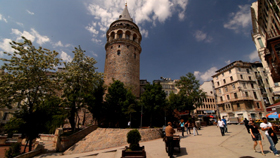 Galata TowerThe tower was built by the Genoese colony as part of their town defense fortifications in the 14th century. In 1967, the tower was restored and an elevator added. The present height of the tower is 63 m / 206 ft. Today two top floors serve as a restaurant with folk shows. During the daytime it is open to visitors for panoramic views of the region.
Galata TowerThe tower was built by the Genoese colony as part of their town defense fortifications in the 14th century. In 1967, the tower was restored and an elevator added. The present height of the tower is 63 m / 206 ft. Today two top floors serve as a restaurant with folk shows. During the daytime it is open to visitors for panoramic views of the region.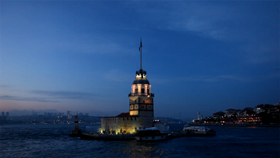 Maiden's Tower One of the most distinctive landmarks in İstanbul is the Maiden's Tower, originally a 12th century Byzantine fortress built on a natural rock. The present structure dates from the 18th century and was used as an inspection station by the Navy. It has now been restored and made into a cafe and restaurant..
Maiden's Tower One of the most distinctive landmarks in İstanbul is the Maiden's Tower, originally a 12th century Byzantine fortress built on a natural rock. The present structure dates from the 18th century and was used as an inspection station by the Navy. It has now been restored and made into a cafe and restaurant..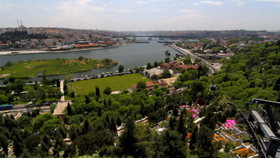 Pierre Loti CafeThis popular cafe overlooking the Golden Horn in the Eyüp area is dedicated to the time that French Novelist Pierre Loti spent in Turkey. He frequently went there.
Pierre Loti CafeThis popular cafe overlooking the Golden Horn in the Eyüp area is dedicated to the time that French Novelist Pierre Loti spent in Turkey. He frequently went there. 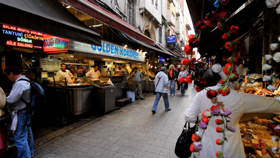 Local MarketsHere we see everyday people going about their everyday activities.
Local MarketsHere we see everyday people going about their everyday activities.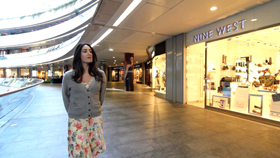 "Kanyon" Deluxe Shopping MallKanyon is much more than a place to shop, live or work; it is almost a mini city within İstanbul, a place where shopping is fun and entertaining.
"Kanyon" Deluxe Shopping MallKanyon is much more than a place to shop, live or work; it is almost a mini city within İstanbul, a place where shopping is fun and entertaining.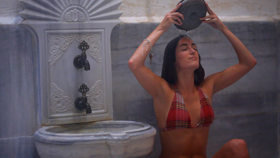 Süleymaniye Hamamı The 16th century historic Turkish bath in İstanbul was commissioned by Sultan Süleyman the Magnificent, and built by Architect Sinan. It was part of the Süleymaniye Mosque complex.
Süleymaniye Hamamı The 16th century historic Turkish bath in İstanbul was commissioned by Sultan Süleyman the Magnificent, and built by Architect Sinan. It was part of the Süleymaniye Mosque complex.
